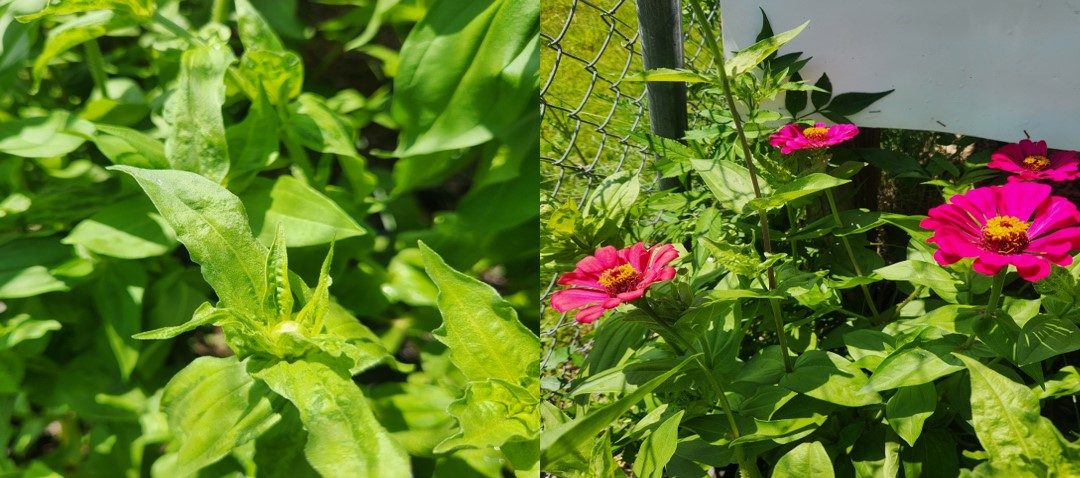
by Donna Arnold | Jul 6, 2025
Zinnia Woes: What’s Causing Terminal Shoot Curling?
On a quiet stroll to the greenhouse early Monday morning, something unusual caught my eye—our zinnia plants looked noticeably different. Their vibrant green shoots had begun to curl at the tips, a subtle but clear sign that all was not well. Do not be alarmed if your zinnias are showing similar symptoms—it is a common issue. Curling at the terminal shoots is often a plant’s way of signaling stress. Whether it is due to environmental factors, pest activity, or nutrient imbalance, these twisted tips are clues worth investigating. Understanding the “why” behind the curl is the first step toward helping your zinnias return to their radiant, blooming selves
Common Culprits Behind Curling Zinnias
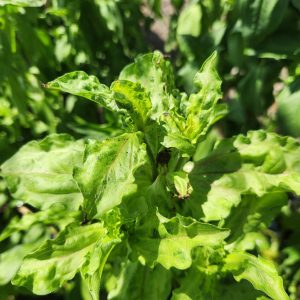
Environmental Stress: Zinnias are sun-lovers, but extreme heat, strong winds, or sudden temperature swings can cause their terminal shoot to curl as a defense mechanism.
Watering Woes: Both overwatering and underwatering can lead to leaf curls. Too much water suffocates roots, while too little causes drought stress—either way, the plant reacts by curling its leaves.
Pests: Aphids, thrips, and spider mites are notorious for feeding on tender new growth. Their sap-sucking habits distort leaves and can transmit viruses.
Diseases: Fungal infections like powdery mildew or bacterial leaf spot can cause curling, especially when combined with poor air circulation.
Nutrient Deficiencies: A lack of nitrogen, magnesium, or manganese can lead to curling and yellowing of new growth. Soil testing can help pinpoint the issue.
What You Can Do:
- Ensure consistent watering—moist but not soggy soil is ideal.
- Inspect regularly for pests and treat with neem oil or insecticidal soap.
- Improve air circulation by spacing plants properly and pruning overcrowded areas.
- Feed with a balanced fertilizer and consider a soil test if symptoms persist.
- Remove and destroy severely affected plants to protect the rest of your garden.
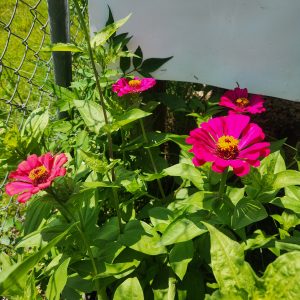
Healthy zinnias reward you with bold, cheerful blooms. A little detective work now can keep your garden dazzling all season long. For more information on Zinnias, contact your local Extension office or follow the links below.
https://gardeningsolutions.ifas.ufl.edu/plants/ornamentals/zinnia/
https://edis.ifas.ufl.edu/publication/FP623
https://nwdistrict.ifas.ufl.edu/hort/category/annuals-2/page/2/#:~:text=When%20planting%20zinnias%2C%20it’s%20recommended,than%20the%20foliage%20whenever%20possible.
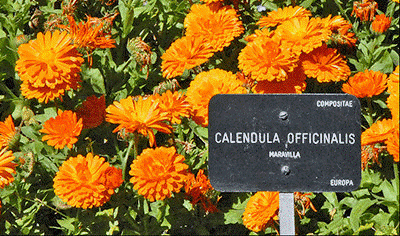
by Donna Arnold | May 22, 2025
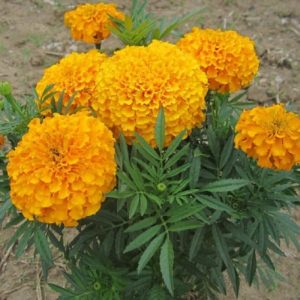
Spring and summer bring an explosion of color to gardens, and among the most resilient yet misunderstood flowers are marigolds. Growing up in a small Caribbean town, marigolds were everywhere. Locals called them “Stink and Pretty” or even “graveyard flowers” for their bold scent, but their benefits were undeniable. Whether used in traditional medicine, religious rituals, or tucked into garden beds to keep pests at bay, marigolds have always been more than just a flower.
More Than Just a Bloom
Belonging to the Tagetes genus, marigolds come in a variety of cultivars, each offering unique traits and advantages. Beyond their beauty, they play essential roles in soil conditioning, pest control, especially against nematodes, and companion planting.
A Closer Look at Marigold Varieties
Marigolds fall into distinct categories, each with different growth habits, flower forms, and benefits. The two most common types are Tagetes patula and Tagetes erecta.
- French Marigold (Tagetes patula)
Compact and bursting with warm hues of orange, yellow, and mahogany, French marigolds are excellent pest deterrents. Often planted alongside vegetables, they help manage soil nematodes while thriving in borders and containers.
- African or Perfection Yellow Marigold (Tagetes erecta)
Despite the name “African,” this species hails from Central America. Taller and more dramatic than French marigolds, it produces large, showy golden blooms ideal for cut flowers and mass plantings.
- Signet Marigold (Tagetes tenuifolia)
Delicate foliage, small dainty flowers, and an edible twist—Signet marigolds are a favorite for adding color to salads and attracting pollinators. Plus, their milder scent makes them perfect for gardeners sensitive to stronger fragrances.
A Common Mix-Up
It’s worth noting that while often called “Pot Marigold,” Calendula officinalis is not part of the Tagetes genus. Though it shares similar colors and benefits, calendula is better known for its medicinal properties and edible petals.
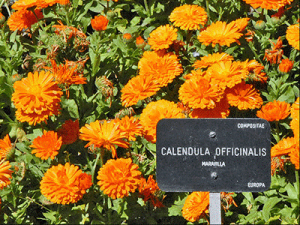
Calendula in the Royal Botanical Garden of Madrid, Spain. Photo by Jean-Pierre Dalbéra.
Next time you pass a tray of marigolds at a plant sale or see them brightening a garden bed, take a second look. These unassuming blooms do far more than add beauty—they may just be the unsung heroes of your summer garden.
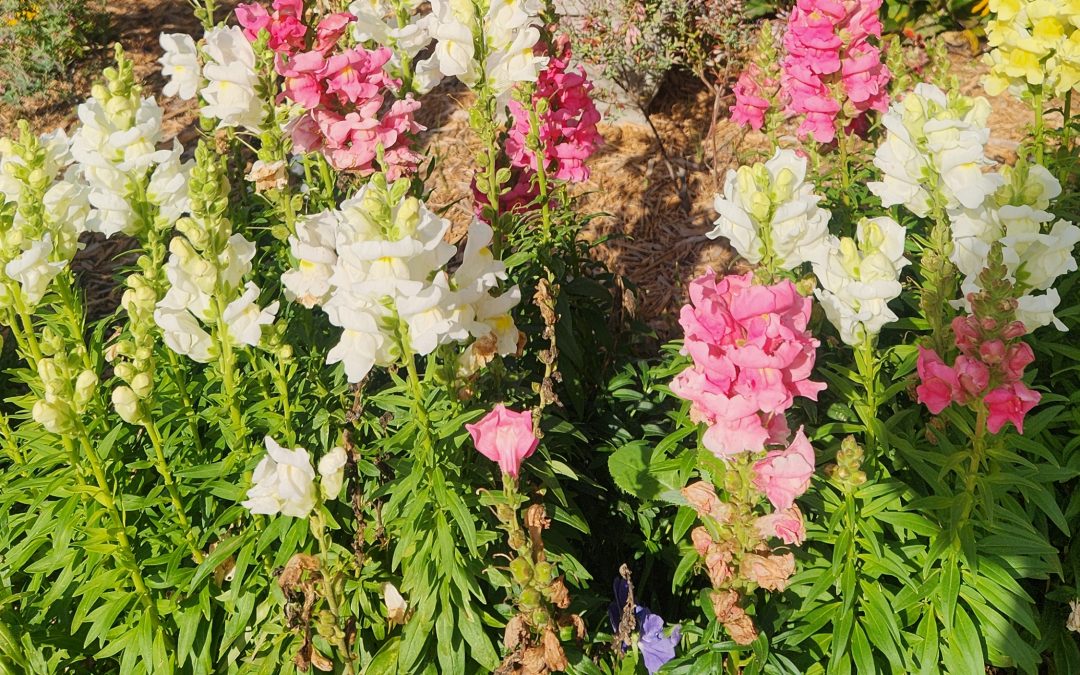
by Donna Arnold | Apr 10, 2025
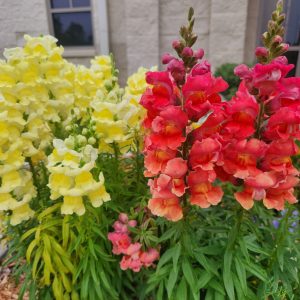
Snapdragon in bloom: Photo credit Donna Arnold FAMU Extension.
Snapdragons (Antirrhinum majus) add vibrant color to fall and winter gardens in North Florida with their wide range of hues. Colors include red, orange, yellow, and maroon. Their growth varies; tall varieties reach 2–3 feet, intermediates 1–2 feet, bedding types 6–15 inches, and rock garden hybrids about 6 inches. Dark-colored flowers often have reddish stems, while pale blooms grow on light green stems. Snapdragons’ warm-colored flowers stand out in garden beds, especially when paired with white flowers, enhancing their red, orange, and maroon tones. Their fine-textured foliage contrasts nicely with large-leaved plants and compact shrubs.
Though not native to North America, they are widely cultivated and are not considered invasive. Snapdragons are versatile and ideal for mass plantings, containers, cut flowers, and edging. They are generally available within their hardiness range, making them a popular gardener choice.
Cultivars
Dwarf: ‘Floral Carpet,’ ‘Floral Showers,’ ‘Kolibri,’ ‘Royal Carpet,’ ‘Tahiti’
Intermediate: ‘Princess,’ ‘Liberty,’ ‘Sonnet,’ ‘Pixie,’ ‘Sprite,’ ‘Cinderella’
Tall: ‘Panorama,’ ‘Burpee’s Topper,’ ‘Spring Giant,’ ‘Rocket’
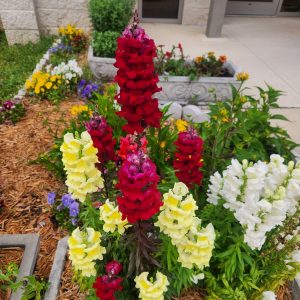
Photo credit: Donna Arnold FAMU Extension.
Care and Management
Caring for Snapdragons requires minimal work. They thrive in slightly acidic garden soil but struggle in unamended clay. Therefore, ensuring the soil remains acidic is key to their survival. They require full sun and moist soil. After the first bloom, cutting plants back to five or six nodes encourages a second flowering. Also, fertilizing at bud formation improves growth.
You can increase numbers through propagation. Propagation can be done through seeds or cuttings. Seeds germinate in 10–14 days at 70°F and should not be covered with soil. Prechilled seeds germinate best. Pinch seedlings with two to three leaf sets, except for dwarf varieties. Plant in fall for winter blooms in zones 9–11. In zone 8b and south, snapdragons may survive mild winters. Space plants 6–10 inches apart.
Pests and Diseases
Aphids: Feed on young growth, weakening plants.
Greenhouse leaf tier: Chews and webs leave; pesticides are ineffective once leaves roll.
Mites: Cause bronzed, stippled foliage, especially in hot weather.
Common Diseases
Rust: Brown pustules with yellowed leaf tissue; use proper spacing and resistant varieties.
Anthracnose: Causes sunken spots on stems and yellowing leaves; destroys infected plants.
Gray mold: Leads to wilting and stem browning; worsens in wet conditions. Remove infected stalks.
Stem rot: Cottony growth near soil line; infected plants should be removed.
Snapdragons offer rich color, versatility, and seasonal interest in gardens, making them a valuable addition for novice and experienced gardeners.
For more information contact your local extension office or click on the following links.
FPS-44/FP044: Antirrhinum majus Snapdragon
ENH1285/EP549: Planting and Propagation of Snapdragons in Florida
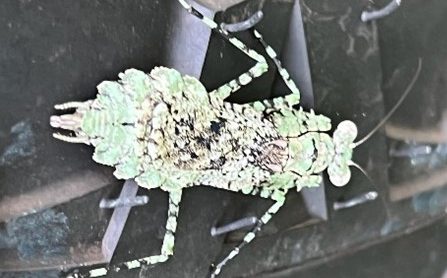
by Donna Arnold | Feb 27, 2025
Extension agents occasionally receive calls about “alien” bug sightings, sparking concern among residents. One such insect, Gonatista grisea, commonly known as the Grizzled Mantis, Florida bark Mantis or Lichen Mimic mantis, often raises alarm. But there’s no need to panic—this mantis is a fascinating and harmless part of our ecosystem.
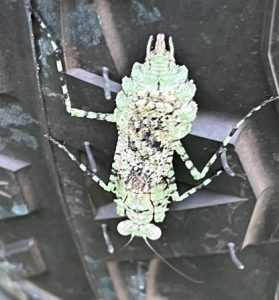
Photo Credit: Vincent Moore, Sweet Magnolia Ridge.
The Grizzled Mantis is native to the United States, ranging from southern Florida to Georgia and South Carolina, and is also found in Puerto Rico, Jamaica, and Cuba. Adults are relatively small, with males measuring 36–38 mm and females slightly larger at 37–40 mm. Their grayish-green coloration and mottled dark markings provide excellent camouflage, allowing them to blend seamlessly into their surroundings, such as lichen-covered bark. They are characterized by triangular heads and large eyes, perfect for their ambush hunting style.
Quick and agile, Grizzled Mantids scuttle rapidly away from perceived threats. They exclusively prey on arthropods, adopting a head-down ambush position while resting on tree bark. Their preferred plants include sea grape, gumbo limbo, water oak, and magnolia, though they are not limited to these species.
Interestingly, mantids are gaining popularity as low-maintenance pets. Some enthusiasts collect egg cases or purchase late-stage nymphs. However, keep in mind that newly hatched mantids require ample food or separation, as they can become cannibalistic if resources are scarce.
Whether in the wild or as pets, the Grizzled Mantis is a unique and beneficial insect, playing a role in controlling arthropod populations. So, the next time you spot one, there’s no need for fear—just appreciation for this remarkable creature!
For more information, contact your local Extension Office or click on the link Grizzled mantid – Gonatista grisea.
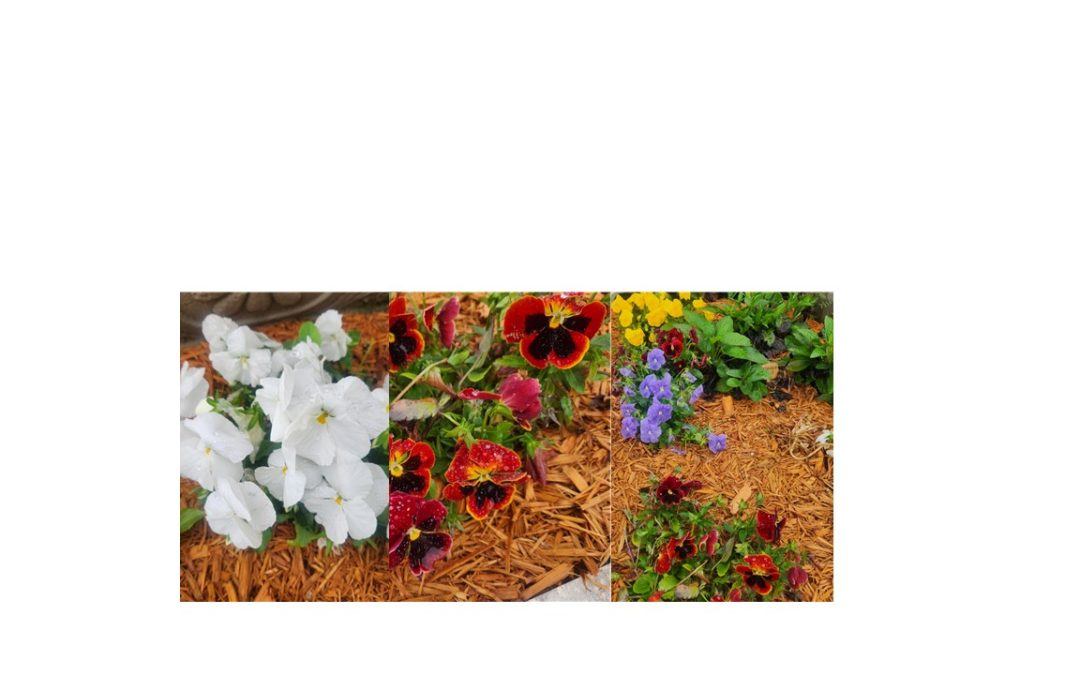
by Donna Arnold | Feb 19, 2025
 Growing pansies in North Florida is a rewarding experience, as these resilient flowers thrive in cooler temperatures. As I walked up to our front office after the ice had melted away, I was amazed to see their vibrant blooms still standing strong, displaying their cheerful faces despite the harsh conditions of the January 2025 winter storm. Their endurance is a testament to their hardiness, making them a perfect choice for winter gardens. Here’s a guide to help you successfully cultivate pansies in our region.
Growing pansies in North Florida is a rewarding experience, as these resilient flowers thrive in cooler temperatures. As I walked up to our front office after the ice had melted away, I was amazed to see their vibrant blooms still standing strong, displaying their cheerful faces despite the harsh conditions of the January 2025 winter storm. Their endurance is a testament to their hardiness, making them a perfect choice for winter gardens. Here’s a guide to help you successfully cultivate pansies in our region.
Best Planting Time
Pansies thrive in cooler weather, making fall (October–November) the ideal time to plant them. Once established, they will provide stunning blooms throughout the winter and into early spring. While they can tolerate mild frosts, Florida’s summer heat is too intense for them, so they are best treated as a seasonal flower.
Choosing the Right Variety
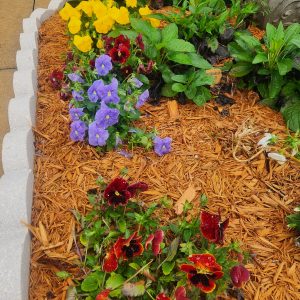 Not all pansies are well-suited for Florida’s fluctuating temperatures. To ensure a successful and long-lasting display, select heat-tolerant varieties such as Majestic Giants, Matrix, or Delta Series, which are known for their resilience and vibrant blooms.
Not all pansies are well-suited for Florida’s fluctuating temperatures. To ensure a successful and long-lasting display, select heat-tolerant varieties such as Majestic Giants, Matrix, or Delta Series, which are known for their resilience and vibrant blooms.
Delta Series – A popular choice for its bold yellow, purple, and blue flowers. This variety is highly valued for its disease resistance, vigorous growth, and ability to withstand both cold and mild heat.
Majestic Giants – A classic pansy cultivar known for its large, eye-catching blooms in a variety of colors and patterns. These compact plants thrive in both container gardens and mass plantings.
Matrix Series – This variety produces dense, bushy plants with large flowers, making it an excellent choice for creating colorful, impactful displays in both garden beds and containers.
By choosing the right variety, you can ensure your pansies thrive throughout the cooler months, bringing beauty and color to your landscape.
Sun and Soil Requirements
For the healthiest plants, provide full sun to partial shade, with at least 4–6 hours of direct sunlight each day. Pansies prefer well-draining soil rich in organic matter, with a slightly acidic to neutral pH (5.5–6.5). Improve your soil’s structure by adding compost or peat moss, which enhances both drainage and nutrient content.
Watering & Care
Maintaining proper moisture levels is key to keeping pansies healthy. Water them 2–3 times a week, ensuring the soil remains moist but not soggy. A layer of mulch will help retain moisture and reduce weed growth. To encourage continuous blooms, apply a balanced, slow-release fertilizer every few weeks and remove spent flowers (deadheading) to keep plants looking fresh and vibrant.
Common Challenges & Solutions
Despite their hardiness, pansies can face a few challenges:
Heat Sensitivity: If temperatures rise unexpectedly, pansies may wilt. Providing afternoon shade can help them cope.
Pests: Keep an eye out for aphids, slugs, and caterpillars. Use insecticidal soap or remove pests by hand to prevent damage.
Fungal Diseases: Avoid overhead watering to prevent root rot and mildew. Ensuring good air circulation will also help reduce disease risks.
Spring Transition
As spring temperatures climb, pansies will naturally begin to decline. To maintain a colorful garden, consider replacing them with heat-tolerant flowers such as zinnias, marigolds, or vincas, which can handle Florida’s warm and humid conditions.
Their cheerful, expressive blooms make them a wonderful choice for adding color and charm to your landscape. Happy planting!
For more information contact your local extension office.














